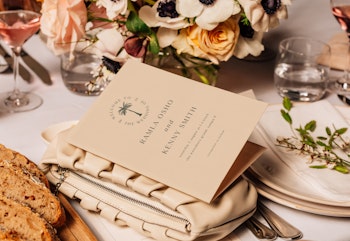While you can’t anticipate sudden downpours, distracted flower girls or latecomers, there are certain things you can do ahead of time to ensure your big day runs as smoothly as possible. From wedding invitations to thank you cards, there are several key pieces of wedding stationery you’ll want, and wedding programs are one of them. But what exactly are they? Simply put, a wedding program provides a step-by-step outline of your wedding day, letting guests know exactly what to expect and where their participation might be needed for things like songs or prayers. But they can also be so much more than that.
We’ve gathered some ideas on what to include in a wedding program and how to give yours a personal touch.
Where style meets function
Beyond being a practical piece of stationery, programs also make for great keepsakes for guests to take home, so you’ll want to make sure they suit the style of your wedding. When picking a design, try to think about the overall theme or destination of your wedding. For example, if you’re getting married by the ocean, something with a marine feel would be a natural fit. Or if you love all things contemporary, why not go for bold lettering or a colorful abstract pattern? Whether you decide to hand yours out to guests as they arrive or leave one on every seat, wedding programs are small enough so that guests can carry them around after the ceremony and frame them after the day.

Who does what and when?
What happens on your wedding day and in what order will have a lot to do with what kind of ceremony you’re having. Most weddings will include some variation on the following: processional, welcome, readings, vows, pronouncement or signing of the registry, kiss and recessional. And while some ceremonies tend to be a little less flexible in terms of structure, there are still plenty of ways you can tailor proceedings to make them more suited to you, from the choice of hymns, songs or readings to the flowers and the decorations.

Covering the basics
So, you’ve settled on a design and you’re ready to get down to the business of writing your wedding program. But what exactly should you include? As a rule of thumb, the front cover should have the couple’s names, the wedding date and the venue, while the back cover can be used for the names of the wedding party, thank yous and details of the reception post-ceremony. As for the inside pages, it’s entirely up to you and your partner. While some orders of service include details like the lyrics to hymns and songs and the text of readings and poems, you can also keep things simple and just stick to the key moments in the ceremony so that everyone understands what's happening when. You could also include a favorite song lyric or inspiring quote about love as a unique touch.
Get inspired
Still stuck for ideas? Check out our template for a non-religious or civil wedding that can be easily customized to suit your big day.
-The cover: Include you and your partner’s names, the name and location of your venue, and the date and time.
-The procession: This marks the entrance of the bridal party, which includes you and your partner, the person marrying you and anyone who has a role in the wedding such as parents, groomsmen, bridesmaids, and flower girls and page boys. If this is happening to music, you might want to include the title of the song.
-Words of welcome: Once everyone is seated, the person officiating will welcome your guests and thank them for bearing witness to your marriage.
-Reading or song: Although they may be mandatory for religious ceremonies, readings are optional for civil ceremonies and can consist of poetry, literature or even be replaced by a song. Whatever you go for, you can choose to include titles and lyrics or full texts in your wedding order of service.
-The marriage ceremony: Again, this depends on the type of wedding you’re having, but this usually consists of an exchange of vows from traditional sources or ones that you’ve written yourselves.
-Exchange of rings: Although optional, the exchange of rings serves as a symbol of the love and trust you and your partner have for one another.
-Second reading or song: This is optional but can be a lovely way of bookending the ceremony.
-Proclamation: Congratulations! The officiant has just proclaimed you married. Now’s the perfect time to seal the deal with a kiss.
-The signing of the register: If you’re having a civil ceremony, you and your new husband or wife will sign the register along with your two witnesses. Details of any music playing in the background can also be included in the order of service.
-The recessional: This is the part where you exit the ceremony venue, followed by your wedding party.
-Back cover: You can choose to leave it empty, use it to thank people and add details of the wedding reception, or include a quote that means something personal to you both as a couple.
Already planning for the big day? Start creating your bespoke wedding program and get creative with our large choice of designs, colors and styles.



